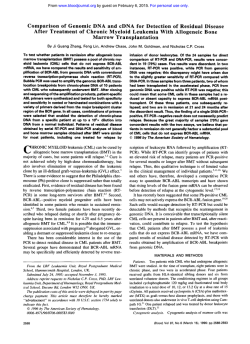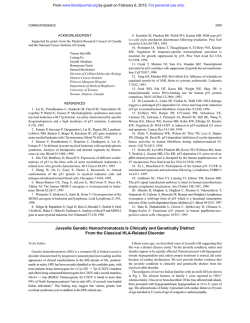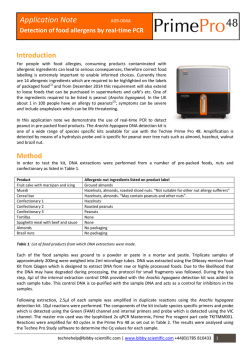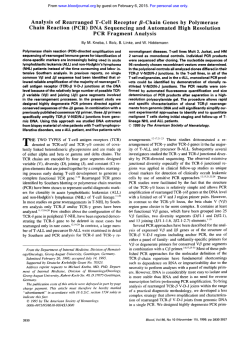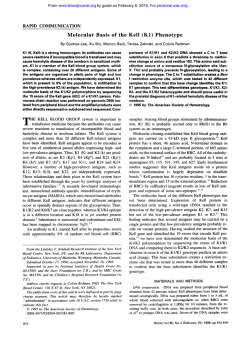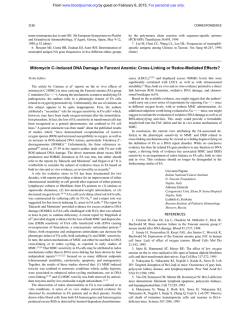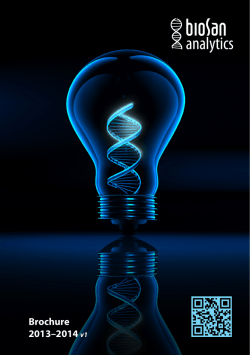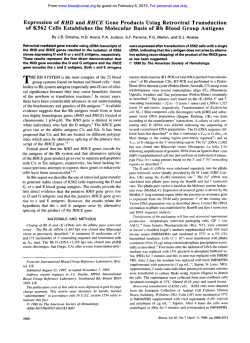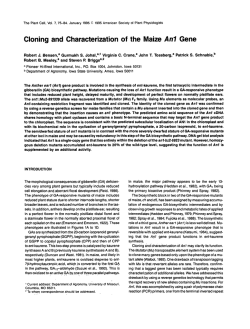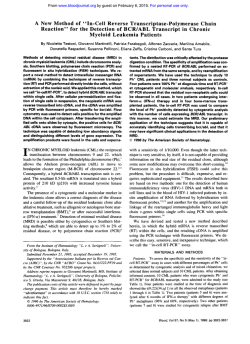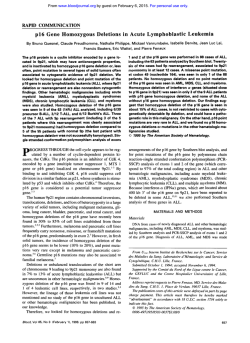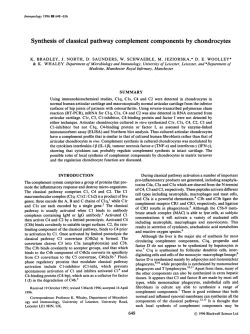
Controls for Reverse Transcriptase-Polymerase Chain
From www.bloodjournal.org by guest on February 6, 2015. For personal use only. 3984 CORRESPONDENCE Controls for Reverse Transcriptase-Polymerase Chain Reaction Amplification of BCR-ABL Transcripts To the Editor: The validity of reverse transcriptase-polymerase chain reaction (RT-PCR) results as evidence of specific gene expression depends on use of appropriate controls. Negative controls are designed to demonstrate absence of PCR products in amplifications of cDNA from cells that do not express the gene and in reactions that do not contain DNA template (“water blanks”). Positive controls should provide evidence that the cDNA template is of good quality for the desired amplification, if the gene in question is actually expressed by the tested cells. Many RT-PCR-based studies include parallel amplifications of the P-actin gene as proof of amplifiable cDNA template. Reports from our laboratory’ and others2have shown the inadequacy of these positive controls, partly because this gene is expressed at high levels, and partly because the 0-actin-amplified products may be also derived from genomic DNA, which is invariably present as a contaminant inRNA preparations. In thecase of RT-PCRtests for expression of the BCR-ABL hybrid gene of chronic myeloid leukemia (CML) and Philadelphia-positive acute lymphoblastic leukemia, some groups use amplifications of a small fragment on the ABL gene to show the presence and quality of the cDNA template. However, we think that these so-called “ABL controls” are inadequate, because the primers3used for these PCRs can promote amplification of ABL sequences present in ( l ) both cDNA and genomic DNA templates, and (2) both the normal ABL allele and the translocated BCR-ABL gene (Fig 1A). The PCR products from these amplifications do not derive necessarily or exclusively from the normal ABL gene transcripts, and therefore are not a suitable control for tests designed to detect or exclude BCR-ABL expression. This problem is particularly relevant when a two-step or “nested” RT-PCR strategy is needed to show “ABL” amplification,’ as illustrated on Fig 1B. For these experiments, RNA was extracted“ from IO5 cells from cell line cultures and from peripheral blood leukocytes from a CML patient (P384), and reverse-transcribed into cDNA as de~cribed.~ Genomic DNAwas extracted from the same samples and purified to 25 ng/pL by standard methods. PCR amplifications were performed as described6 in a 20-pL reaction from 1 pL DNA From www.bloodjournal.org by guest on February 6, 2015. For personal use only. CORRESPONDENCE 3985 A Genomic DNA In+ Cl+ C2- " C cDNA c3- c 4 cDNA Gen. DNA Fig 1. (A) Schematic representation of the 5' end of the ABL gene locus (genomic DNA), and of normal ABL and BCR-ABL transcripts IcDNAI. The relative positions of the PCR primers are indicated by arrows. The sequences of these primers are: In' = (5')TCAGAAlTCCCCCCmCTClTCCAG; C l + = (5')lTCAGCGGCCAGTAGCATCTGACTT; C I (5')TAACACTCTAAGCATAACTAAAG; C T = 15')CCAAGCAACTACATCACGCCAGTCAACA. Ethidium-bromide stained agarose gels show products of PCR amplifications CT,(C) CT' CI,and (D) with primers (B) Cl' In' CI. M, 123-bp DNA ladder lGlBC0 BRL, Paisley, Scotland); N1 and N2 are no-DNA negative controls for first- and second-step PCRs, respectively. + + ++ ++ (for first-step PCR) or 1 pL neat or diluted products from the firststep (for nested PCR) as templates. PCR with primers C l + (in ABL exon 2) and C3- (in ABL exon 3) produced a 275-bp fragment from the cDNA templates (Fig IB, lanes 1 through 4). including that from KYO-I cells which, like the EM-2 cell line used by others as control for BCR-ABL and ABL expression,' lack a normal chromosome 9,' and do not express the normal ABL gene? Therefore, in this case the amplified exon 2- exon 3 ABL sequence must be. derived exclusively from the BCRABL transcripts. The same primer combination was able to pronwte amplification also of genomic DNA templates (Fig lB, lanes 5 through 8) in the form of an 875-bp fragment containing a 600-bp intron' between ABL exons 2 and 3. Heminested PCRs of a 1 : 4 0 0 dilution of first-step products with primers within ABL exon 2 (Cl' C 2 3 produced a 172 bp-fragment in all samples (Fig IC), regardless of their original template preparation @DNA v genomic DNA) or - From www.bloodjournal.org by guest on February 6, 2015. For personal use only. CORRESPONDENCE 3986 of the number of genes and transcripts contributing to the ABL exon 2 sequence amplification (HL60: only normal ABL; KYO-1: only BCR-ABL; K562 and P384: both normal ABL and BCR-ABL). The fact that cDNA preparations contain amplifiable amounts of genomic DNA was confirmed by positive amplifications of these preparations using a 26-mer sense primer (In’) located at the 3’ end of the intron’ preceding ABL exon 2 and the antisense C2- primer (not shown). Furthermore, positive amplifications were also obtained C2-) with this primer pair when using the diluted first-step (Cl’ PCRs as templates, confirming the presence of amplifiable amounts of genomic DNA carried over from the cDNA preparations even after extensive dilution (Fig ID). Identical results for all the PCRamplificationsdescribed here were observed whenusingABL antisense C3- primer-specific cDNA synthesis,’ and whencellular RNA was extracted by two other methods, 10.1 I This suggests that “cDNA preparations” that are actually devoid of any cDNA (because of RNA loss or degradation, or failure of reverse transcription), but are contaminated with genomic DNA during theRNA extraction process, could still produce an “ABL positive” amplification product with no RT-PCR control value. In conclusion, we suggest caution in the interpretation of negative RT-PCR results for BCR-ABL when the “positive control” amplification test is not cDNA specific and single-gene specific. Demonstration of normal ABL or normal BCR expression as evidence of cDNA integrity requires amplification with primers framing a normal sequence that is disrupted in the formation of the BCR-ABL gene, ie, the junction of exons Ib-a2 or Ia-a2 for ABL, and the fragment comprising exons b2 to b4 for BCR. ++ Junia V. Melo Natasha S. Kent Xiu-Hua Yan John M. Goldman LRF Centre for Adult Leukaemia Departmeni of Haematology RPMS, Hammersmith Hospital London, UK REFERENCES 1. Cross NCP, Lin F, Goldman JM: Appropriate controls for reverse transcription polymerase chain reaction (RT-PCR). Br J Haematol87:218, 1994 2. Taylor JJ, Heasman PA: Control genes for reverse transcriptase/polymerase chain reaction (RT-PCR). Br J Haematol 86:444, 1994 3. Keating A,Wang XH, Laraya P: Variable transcription of BCR-ABL byPh’ cells arising from hematopoietic progenitors in chronic myeloid leukemia. Blood 83:1744, 1994 4. Chomczynski P, Sacchi N: Single-step method of RNA isolation by acid guanidinium thiocyanate-phenol-chloroformextraction. Anal Biochem 162:156, 1987 5 . Cross NCP, Melo JV, Feng L, Goldman JM: An optimized multiplex polymerase chain reaction (PCR) for detection of BCRABL fusion mRNAs in haematological disorders. Leukemia 8: 186, 1994 6 . Melo JV, Goldman JM: Specific point mutations that activate v-ab1 are not found in Philadelphia-negativechronic myeloid leukaemia, Philadelphia-negative acute lymphoblastic leukaemia or blast transformation of chronic myeloid leukaemia. Leukemia 6:786, 1992 7. Keating A: Ph positive CML cell lines. Baillieres Clin Haemato1 1:1021, 1987 8. Melo JV, Gordon DE, Cross NCP, Goldman JM: The ABLBCR fusion gene is expressed in chronic myeloid leukemia. Blood 81:158, 1993 9. Grosveld G, Venvoerd T, van Agtboven T, de Klein A, Ramachandran KL, Heisterkamp N. Stam K, Groffen J: The chronic myelocytic cell line K562 contains a breakpoint in bcr and produces a chimeric bcr/abl transcript. Mol Cell Biol 6607, 1986 10. Sambrook J, Fritsch EF, Maniatis T Molecular Cloning: A Laboratory Manual. Cold Spring Harbor, NY, Cold Spring Harbor Laboratory, 1989 11. Higuchi R: Simple and rapid preparation of samples for PCR, in Erlich HA (ed): PCR Technology. New York, NY, Stockton. 1989, p 31 From www.bloodjournal.org by guest on February 6, 2015. For personal use only. 1994 84: 3984-3986 Controls for reverse transcriptase-polymerase chain reaction amplification of BCR-ABL transcripts [letter] JV Melo, NS Kent, XH Yan and JM Goldman Updated information and services can be found at: http://www.bloodjournal.org/content/84/11/3984.citation.full.html Articles on similar topics can be found in the following Blood collections Information about reproducing this article in parts or in its entirety may be found online at: http://www.bloodjournal.org/site/misc/rights.xhtml#repub_requests Information about ordering reprints may be found online at: http://www.bloodjournal.org/site/misc/rights.xhtml#reprints Information about subscriptions and ASH membership may be found online at: http://www.bloodjournal.org/site/subscriptions/index.xhtml Blood (print ISSN 0006-4971, online ISSN 1528-0020), is published weekly by the American Society of Hematology, 2021 L St, NW, Suite 900, Washington DC 20036. Copyright 2011 by The American Society of Hematology; all rights reserved.
© Copyright 2025


